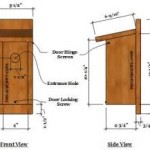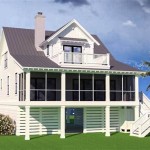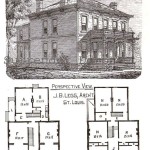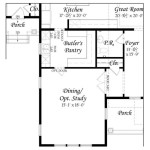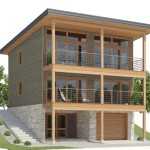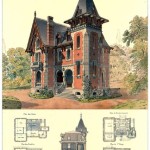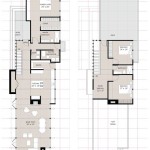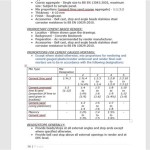House Plans for 2-Family Homes in Georgia's Countryside
The demand for multi-family housing is growing across the United States, driven by factors such as rising housing costs, multigenerational living arrangements, and the desire for shared living expenses. In Georgia, particularly in its picturesque countryside, 2-family homes, also known as duplexes, offer a compelling solution to these needs. These homes provide separate living spaces within a single structure, promoting both privacy and proximity for residents. This article explores the various aspects of house plans for 2-family homes in rural Georgia, outlining key considerations and design elements to achieve functional, attractive, and legally compliant dwellings.
Designing a 2-family home differs significantly from planning a single-family residence. It requires careful consideration of zoning regulations, separate utility access, soundproofing, and aesthetically pleasing design that integrates well with the surrounding rural landscape. The intent is to create two distinct living units that offer comfort, privacy, and independent functionality for each household. Selecting the right house plan is the crucial first step in bringing this vision to reality.
The architectural styles available for 2-family homes range widely, from traditional farmhouse designs blending seamlessly with the rural aesthetic to more contemporary styles incorporating modern features. Material choices play a significant role in both the aesthetic appeal and the durability of the structure, particularly given Georgia's climate. Cost considerations are also paramount, necessitating a balance between design ambitions and budgetary constraints to ensure a financially viable project.
Zoning Regulations and Building Codes in Rural Georgia
Before embarking on the design process, a thorough understanding of local zoning regulations and building codes is essential. These regulations dictate the permissible types of construction, lot size requirements, setbacks from property lines, and other crucial parameters. Rural zoning often differs significantly from urban zoning, and counties may have unique stipulations regarding multi-family dwellings.
It is imperative to consult with the relevant county planning and zoning department to obtain the most up-to-date information. This research should clarify whether 2-family homes are permitted in the desired location and, if so, what specific requirements must be met. Factors such as minimum lot size, maximum building height, parking requirements, and landscaping regulations can directly influence the design of the home. A failure to comply with these regulations can result in costly delays and potential legal issues.
Beyond zoning, building codes establish minimum standards for the structural integrity, safety, and energy efficiency of the building. These codes address aspects such as foundation construction, framing, electrical wiring, plumbing, and HVAC systems. Georgia adheres to the International Building Code (IBC) and the International Residential Code (IRC), with potential local amendments. Adherence to these codes is mandatory to obtain building permits and ensure the safety of the occupants.
Engaging with a qualified architect or building professional with experience in Georgia's rural construction landscape is highly recommended. They can navigate the complexities of zoning regulations and building codes, ensuring that the house plan is compliant and optimized for the specific location. This expertise can save time, money, and potential headaches throughout the construction process.
Key Design Considerations for 2-Family Homes
Creating a successful 2-family home design involves careful consideration of several key factors. The aim is to provide comfortable and independent living spaces for each household while maximizing the use of available space and minimizing construction costs.
One of the primary considerations is the configuration of the living units. There are several common layouts, including side-by-side duplexes, stacked duplexes (one unit above the other), and units positioned at angles to each other. The choice of layout depends on factors such as lot size, topography, and desired level of privacy. Side-by-side duplexes typically offer greater privacy and easier access to outdoor spaces, while stacked duplexes can be more efficient in terms of land use. Designing a layout that logically separates the units and minimizes noise transmission is vital for maintaining harmonious co-existence.
Separate entrances are essential for each unit to ensure privacy and a sense of independence. Ideally, each unit should have its own private driveway or designated parking area. Outdoor living spaces, such as patios, decks, or yards, should also be clearly delineated to prevent overlap and potential conflicts. Thoughtful landscaping can enhance privacy and create visual separation between the units.
Interior design should prioritize functionality and maximize the use of space. Each unit should have its own kitchen, bathrooms, and living areas. Adequate storage space is crucial for both units to avoid clutter and maintain organization. Attention to detail in areas such as lighting, flooring, and cabinetry can significantly enhance the livability of each unit.
Soundproofing is another critical consideration, especially in shared walls and floors. Techniques such as using sound-dampening insulation, staggered stud construction, and resilient channels can effectively reduce noise transmission between units. Addressing soundproofing during the design phase is far more cost-effective than attempting to mitigate noise issues after the building is complete.
Architectural Styles and Material Choices
The architectural style of a 2-family home should complement the surrounding rural landscape and reflect the character of the region. Several architectural styles are well-suited to Georgia's countryside, including traditional farmhouse, craftsman, and ranch styles. Each style offers unique design features and aesthetic appeal.
Farmhouse designs typically incorporate elements such as gabled roofs, covered porches, and board-and-batten siding. These homes often feature large windows to maximize natural light and provide views of the surrounding scenery. Craftsman-style homes are characterized by their emphasis on handcrafted details, such as exposed rafters, tapered columns, and wide eaves. Ranch-style homes are known for their single-story design and horizontal orientation, making them well-suited to flat or gently sloping lots.
The choice of building materials is influenced by factors such as cost, durability, aesthetics, and environmental impact. Common exterior materials include wood siding, brick veneer, vinyl siding, and fiber cement siding. Wood siding offers a natural and aesthetically pleasing look but requires regular maintenance. Brick veneer provides a durable and low-maintenance option, while vinyl siding is a cost-effective and weather-resistant choice. Fiber cement siding offers a balance of durability, aesthetics, and affordability.
Roofing materials should be chosen for their durability, weather resistance, and aesthetic appeal. Asphalt shingles are a common and affordable option, while metal roofing offers superior longevity and energy efficiency. Tile roofing provides a distinctive and durable option, but it can be more expensive.
Consideration of energy efficiency is also paramount. Incorporating energy-efficient windows, insulation, and HVAC systems can significantly reduce utility costs and minimize the home's environmental footprint. Passive solar design principles, such as orienting the home to maximize sunlight exposure during the winter and minimize it during the summer, can further enhance energy efficiency. Utilizing sustainable building materials, such as recycled content products and locally sourced lumber, can also contribute to a more environmentally responsible project.
Ultimately, the choice of architectural style and building materials should reflect the owner's preferences, budget, and the overall context of the rural setting. A well-designed 2-family home can enhance the beauty of the countryside while providing comfortable and functional living spaces for two families.
Navigating the complexities of designing and building a 2-family home in Georgia's countryside requires careful planning, attention to detail, and collaboration with experienced professionals. By understanding zoning regulations, considering key design elements, and selecting appropriate architectural styles and materials, it is possible to create a dwelling that meets the needs of two families while seamlessly integrating into the rural landscape.

Symmetrical House Georgian Plans Floor The Designers
Dream 2 Family House Plans Designs

8 Fabulous Family Home Plans Blog Dreamhomesource Com

12 Simple 2 Bedroom House Plans With Garages Houseplans Blog Com

Symmetrical House Georgian Plans Floor The Designers

House Plans Floor Blueprints

Top 10 Duplex Plans That Look Like Single Family Homes Houseplans Blog Com

Spacious And Open Best Floor Plans For Families Blog Homeplans Com

2 Bedroom House Plans Dream Home Source

New Construction Homes For In Georgia Ga Realtor Com
Related Posts

